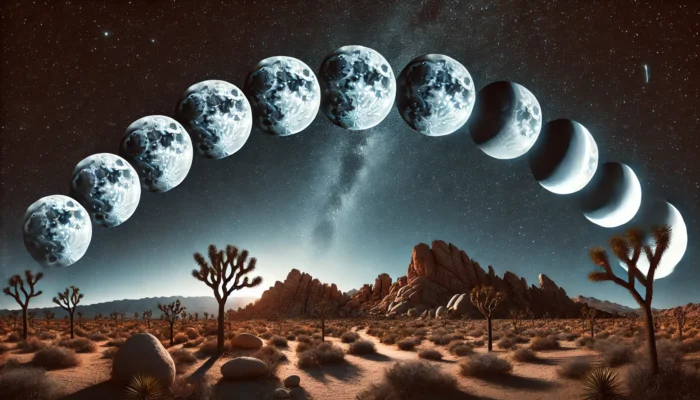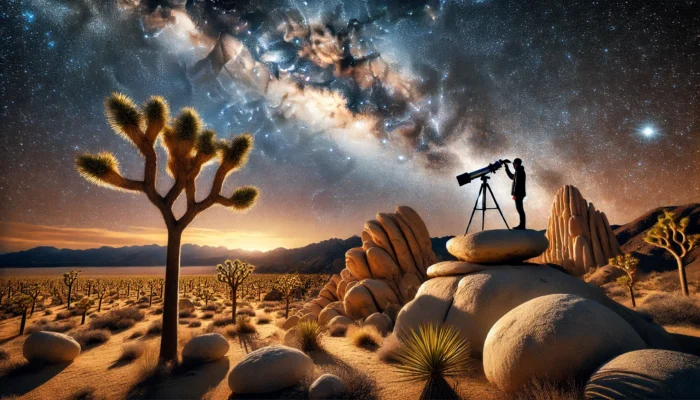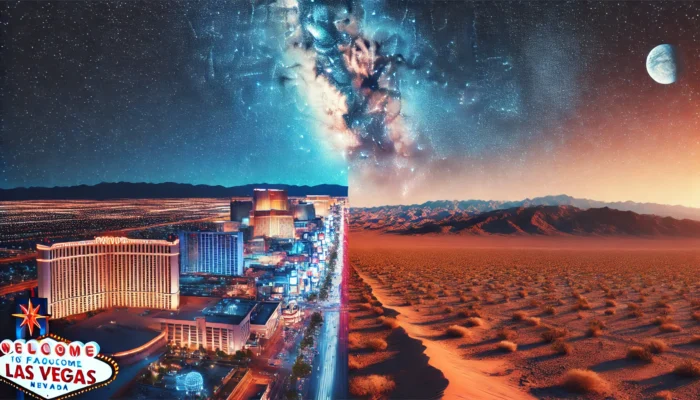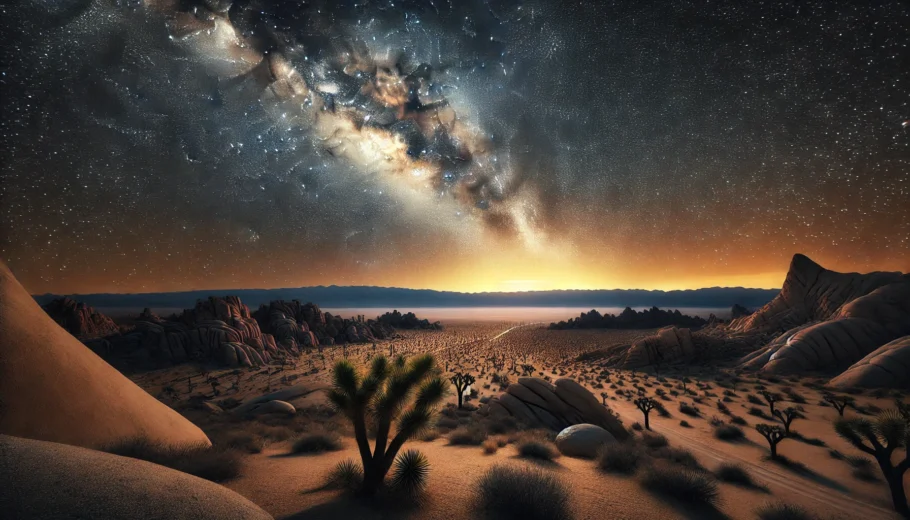Las Vegas is known for its dazzling lights, but step beyond the city, and you’ll find some of the darkest skies in the country. The Mojave Desert offers vast, open landscapes with minimal light pollution, making it one of the best places in the world for stargazing. Whether you’re a casual skywatcher or a dedicated astrophotographer, the Mojave Desert provides an unparalleled celestial experience. In this guide, we’ll explore the top stargazing spots in the Mojave Desert, covering everything from national parks to remote wilderness areas.
Stop right here – Vegas insider tip: Most visitors to this site will overpay by $727+ per trip to Las Vegas. Why? Because they don't have the secrets and tips to keep expenses low in Vegas while having a good time. Want the complete playbook for traveling like a Vegas local? Click here to save money on Vegas trips
Why the Mojave Desert is Perfect for Stargazing
With its vast, open landscapes and minimal light pollution, the Mojave Desert offers some of the clearest night skies in the world. High elevation, dry air, and stable atmospheric conditions make it an ideal destination for both casual stargazers and serious astronomers. Whether you’re admiring the Milky Way or capturing deep-sky objects, the Mojave provides a breathtaking celestial experience.
Low Light Pollution
- The Mojave Desert is one of the least populated areas in the United States, ensuring minimal artificial light.
- Many areas are protected by national parks, limiting urban development and preserving dark skies.
- Some locations are officially recognized as Dark Sky Parks by the International Dark-Sky Association (IDA).
- Unlike many coastal areas, there are fewer large cities nearby that contribute to sky glow.
- Rural communities in the Mojave often enforce strict outdoor lighting regulations to reduce light pollution.
High Elevation and Dry Climate
- Many stargazing spots in the Mojave are at elevations above 3,000 feet, providing clearer skies.
- The dry desert air reduces atmospheric moisture, which can otherwise distort celestial views.
- Fewer clouds and low humidity mean more nights with excellent visibility.
- The lack of vegetation and wide-open landscapes give unobstructed 360-degree sky views.
- The desert’s stable air reduces turbulence, improving telescope clarity.
Year-Round Visibility
- The Mojave Desert’s mild winters allow for stargazing even during colder months.
- Summer nights, though warm, provide excellent opportunities for viewing the Milky Way.
- Seasonal meteor showers, like the Perseids and Geminids, are easily visible due to the dark skies.
- The desert’s remote location reduces haze and smog, ensuring consistent visibility.
- Star parties and astronomy events occur throughout the year, taking advantage of these conditions.
Best Times for Stargazing in the Mojave Desert
Timing plays a crucial role in getting the best stargazing experience in the Mojave Desert. Factors such as moon phases, seasonal changes, and weather conditions can greatly impact visibility. Understanding when to go ensures the best chance of seeing the stars, planets, and cosmic events in all their brilliance.

Moon Phases and Dark Skies
- The best time for stargazing is during the new moon when the sky is at its darkest.
- A crescent moon may still allow for decent stargazing while adding some illumination to the landscape.
- A full moon, while beautiful, can wash out many celestial objects and dim the Milky Way.
- Lunar calendars and apps can help plan visits around ideal stargazing conditions.
- Some astronomers use the first few hours after moonset for optimal dark sky conditions.
Seasonal Highlights
- Winter: Best time for crisp, clear skies and viewing Orion’s Belt, the Pleiades, and the Andromeda Galaxy.
- Spring: Ideal for seeing distant galaxies like the Virgo Cluster and star clusters such as the Beehive Cluster.
- Summer: The Milky Way shines brightest in July and August, with the center of our galaxy visible overhead.
- Fall: Great for planetary observation, with Jupiter and Saturn commonly visible in the early evenings.
- Meteor showers: Major events like the Perseids (August) and Geminids (December) put on dazzling displays.
Weather Considerations
- Clear nights are most common, but occasional storms can bring temporary cloud cover.
- The desert’s rapid temperature drops after sunset require warm clothing, even in summer.
- High winds can make telescope stabilization difficult in exposed locations.
- Checking weather forecasts before heading out can help avoid cloudy nights.
- Avoid monsoon season (July to September), as thunderstorms can obscure visibility.
Top Stargazing Spots in the Mojave Desert
The Mojave Desert is home to some of the darkest and most scenic stargazing locations in the United States. From national parks to remote wilderness areas, there are plenty of places to experience the night sky in its purest form. Each destination offers unique vantage points, making it perfect for both viewing and astrophotography.

Death Valley National Park
- One of the largest and darkest national parks in the United States.
- Recognized as a Gold Tier International Dark Sky Park by the IDA.
- Popular spots include Badwater Basin, Dante’s View, and Mesquite Flat Sand Dunes.
- Offers ranger-led astronomy programs and special events during winter months.
- Elevation changes within the park allow for varied perspectives of the night sky.
Mojave National Preserve
- Encompasses over 1.6 million acres of protected land, ensuring minimal light pollution.
- Kelso Dunes provides a stunning foreground for astrophotography.
- The Hole-in-the-Wall area is ideal for secluded stargazing away from any light sources.
- Higher elevation areas, such as Mid Hills, offer clear and stable atmospheric conditions.
- Campgrounds allow for overnight stays under the stars without urban disturbances.
Red Rock Canyon National Conservation Area
- Located just outside of Las Vegas but still offers dark skies with a short drive.
- Best views are found along the Scenic Drive and the Calico Hills area.
- Offers astronomy nights hosted by local stargazing groups and rangers.
- Large rock formations provide interesting foregrounds for astrophotography.
- Winter nights are especially dark due to fewer visitors and clearer skies.
Joshua Tree National Park
- Famous for its alien-like landscapes and pristine dark skies.
- Officially designated as an International Dark Sky Park.
- The southern part of the park, around Cottonwood Campground, is the darkest area.
- Hidden Valley and Keys View offer high elevations with incredible views of the Milky Way.
- Regular night sky festivals and educational programs draw amateur and professional astronomers alike.
Valley of Fire State Park
- Nevada’s oldest state park with stunning red rock formations illuminated by starlight.
- Remote location ensures significantly reduced light pollution.
- White Domes Trail provides high-elevation viewing away from visitor centers.
- No artificial lights within the park help preserve the natural night sky.
- A great spot for both stargazing and astrophotography due to its unique geological features.
Essential Tips for Stargazing in the Mojave Desert
To make the most of your stargazing adventure, preparation is key. Having the right equipment, understanding safety precautions, and knowing how to navigate the dark desert environment will enhance your experience. Whether you’re a beginner or an experienced observer, these tips will help you enjoy the night sky to the fullest.

Equipment and Gear
- A telescope or binoculars can enhance views of planets and deep-sky objects.
- A star chart or astronomy app helps identify constellations and celestial bodies.
- Red flashlight preserves night vision while navigating in the dark.
- Warm clothing, even in summer, as desert temperatures drop significantly at night.
- A comfortable chair or blanket makes extended stargazing sessions more enjoyable.
Safety Considerations
- Always check weather forecasts and be prepared for sudden temperature changes.
- Be aware of wildlife, including snakes and scorpions, especially during warmer months.
- Carry extra water, as desert air can be extremely dry even at night.
- Let someone know your location and estimated return time when venturing into remote areas.
- Avoid using bright white lights to prevent disturbing both wildlife and fellow stargazers.
Photography Tips
- Use a tripod and long exposure settings to capture stunning night sky images.
- A wide-angle lens helps include landscape features for dramatic compositions.
- Adjust ISO settings for brighter images but avoid excessive noise.
- Experiment with different shutter speeds to capture movement, such as meteors.
- Plan shots around celestial events, such as the Milky Way’s position or planetary alignments.
Celestial Events to Watch in the Mojave Desert
The Mojave Desert is one of the best places in the world to witness spectacular celestial events. With vast open landscapes, high elevations, and minimal light pollution, it offers ideal conditions for stargazing. From dazzling meteor showers to rare planetary alignments, the desert sky is full of wonders. Below, we explore some of the most breathtaking astronomical events you can experience in the Mojave Desert.
Stop right here – Vegas insider tip: Most visitors to this site will overpay by $727+ per trip to Las Vegas. Why? Because they don't have the secrets and tips to keep expenses low in Vegas while having a good time. Want the complete playbook for traveling like a Vegas local? Click here to save money on Vegas trips
Meteor Showers
Meteor showers occur when Earth passes through trails of debris left behind by comets, creating streaks of light across the sky. The dark, clear skies of the Mojave Desert make these showers even more vivid and breathtaking.
- The Perseids (August) and Geminids (December) are among the most spectacular, with peak rates of 100+ meteors per hour.
- The desert’s minimal light pollution allows even faint meteors to be visible to the naked eye.
- The best time to view meteor showers is after midnight, when Earth is moving directly into the debris field.
- Lying flat and giving your eyes 30 minutes to adjust to the dark enhances visibility.
- Locations like Death Valley, Mojave National Preserve, and Joshua Tree offer unobstructed views and ideal conditions.
Eclipses and Lunar Events
Eclipses are among the most mesmerizing celestial phenomena, and the Mojave Desert provides a perfect stage for these rare occurrences. Whether it’s a blood-red lunar eclipse or a total solar eclipse, these events are unforgettable.
- Total lunar eclipses occur when Earth’s shadow completely covers the Moon, turning it a deep red due to sunlight filtering through Earth’s atmosphere.
- Partial lunar eclipses are still worth watching, as a portion of the Moon darkens while remaining partially lit.
- Total solar eclipses, while rare in the Mojave, temporarily turn day into night and reveal the Sun’s corona.
- Annular solar eclipses create a stunning “ring of fire” effect when the Moon is too far to fully block the Sun.
- Supermoons, when the Moon appears larger and brighter due to its closer orbit, offer excellent viewing and photography opportunities.
Planetary Alignments and Conjunctions
Planetary alignments occur when two or more planets appear close together in the sky. These rare celestial arrangements create stunning visual spectacles.
- Grand conjunctions, like the 2020 Jupiter-Saturn alignment, occur every 20 years and create a striking “double planet” effect.
- Venus and Jupiter conjunctions are among the brightest and most beautiful, often visible just after sunset or before sunrise.
- Mars oppositions, occurring every two years, make the Red Planet appear larger and brighter than usual.
- Mercury’s greatest elongation provides rare chances to see the elusive planet when it’s farthest from the Sun.
- Triple planetary alignments, though rare, create unique celestial triangles visible to the naked eye.
Rare and Special Celestial Events
Beyond regular astronomical phenomena, some events are so rare that witnessing them is a once-in-a-lifetime experience. These occurrences make the Mojave Desert an extraordinary place for astronomy enthusiasts.
- Bright comets, like NEOWISE in 2020, occasionally pass close to Earth and are visible with the naked eye.
- Aurora borealis, though extremely rare in the Mojave, can sometimes appear during strong solar storms.
- Supernovae in nearby galaxies can be visible through telescopes, offering a glimpse of massive stellar explosions.
- Zodiacal light, a faint glow caused by interplanetary dust, is visible in extremely dark desert locations.
- Lunar occultations, where the Moon passes directly in front of a planet or star, create stunning visual events.
Vegas by Day, Stars by Night
Las Vegas is known for its world-class entertainment, vibrant nightlife, and luxury experiences, but it also serves as the perfect gateway to some of the best stargazing locations in the Mojave Desert. A well-planned day in Vegas can seamlessly transition from the excitement of the Strip to the serene beauty of the night sky. Here’s how you can enjoy the best of both worlds.

Morning: Breakfast and Exploration
Start your day by indulging in some of the best breakfast and brunch spots in Las Vegas before heading out to explore the city’s unique attractions.
- The Peppermill Restaurant & Lounge offers a classic Vegas breakfast with a retro vibe and oversized portions.
- Mon Ami Gabi at Paris Las Vegas provides a charming patio experience with stunning views of the Bellagio Fountains.
- Red Rock Canyon National Conservation Area is a short drive from the Strip and perfect for a morning hike before the desert heat sets in.
- The Neon Museum is a must-visit for history buffs, showcasing iconic vintage Vegas signs.
- A walk along Fremont Street allows you to experience the old-school charm of downtown Las Vegas.
Afternoon: Luxury, Relaxation, and Thrill
Las Vegas is all about indulgence, so the afternoon is the perfect time to experience its high-end dining, shopping, or thrill-seeking activities.
- A spa day at the Bellagio, Wynn, or ARIA offers a relaxing retreat before your night of adventure.
- Lunch at the Cosmopolitan’s Secret Pizza or Hell’s Kitchen by Gordon Ramsay guarantees a memorable culinary experience.
- Shopping at The Forum Shops at Caesars Palace or The Shops at Crystals provides luxury retail therapy.
- For adrenaline junkies, a helicopter ride over the Grand Canyon or SkyJump at The STRAT is a perfect way to add excitement to the day.
- Explore AREA15, an immersive art and entertainment complex with mind-bending experiences like Meow Wolf’s Omega Mart.
Evening: Sunset and Dinner with a View
Before heading into the desert for stargazing, enjoy a stunning Vegas sunset with an unforgettable dinner.
- The High Roller Observation Wheel offers breathtaking panoramic views of the city skyline at sunset.
- Dinner at Top of the World at The STRAT allows you to dine in a revolving restaurant with 360-degree views.
- Lakeside at Wynn offers fine dining with a beautiful water show featuring animatronic fish.
- The Foundation Room at Mandalay Bay provides an upscale lounge experience with one of the best views of the Strip.
- Catch the Bellagio Fountains or Mirage Volcano Show for a final taste of Vegas entertainment before heading out to the desert.
Night: Stargazing in the Mojave Desert
After the bright lights of Vegas, escape to the tranquility of the Mojave Desert for an unforgettable night under the stars. Within an hour’s drive, you can find yourself in complete darkness, with crystal-clear views of the cosmos.
- Red Rock Canyon National Conservation Area is just 30 minutes from the Strip and offers dark skies and dramatic rock formations.
- Valley of Fire State Park, about an hour away, provides a remote, peaceful setting perfect for stargazing.
- Mojave National Preserve is a further drive but offers some of the darkest skies in the Southwest.
- Death Valley National Park, an International Dark Sky Park, is ideal for seeing the Milky Way in its full glory.
- Pack a telescope, blanket, and warm clothes, and allow your eyes to adjust to the darkness for the best experience.
Spending a day in Las Vegas doesn’t have to end with neon lights—it can transition into a magical night under a sky filled with stars. The Mojave Desert offers a stunning contrast to the city’s bright lights, allowing you to experience the best of both worlds in a single day.
Embracing the Magic of the Mojave Sky
The Mojave Desert offers one of the most spectacular night sky experiences in the world, making it a must-visit destination for stargazers. Whether you’re watching a meteor shower, witnessing a rare planetary alignment, or simply marveling at the Milky Way, the desert’s pristine darkness provides the perfect backdrop. Pairing a day in Las Vegas with an evening under the stars allows you to experience the best of both worlds—glitz and glamour followed by cosmic wonder. So, the next time you find yourself in the Entertainment Capital of the World, take a detour into the desert and let the universe put on a show.





